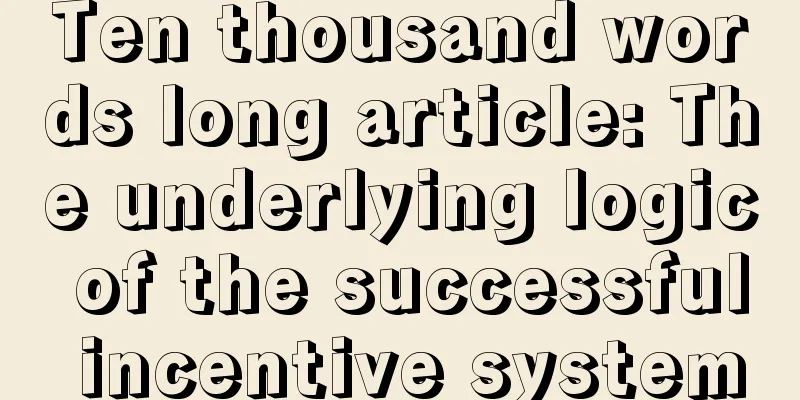Ten thousand words long article: The underlying logic of the successful incentive system

Have you ever participated in the frequent flyer programs of major airlines and exchanged miles for air tickets? Or you can check in on various English learning apps and forward it to your friends circle, and get your tuition fee refunded if you persist for 30 days? Or the year-end performance sprint where you work hard and overtime just to get the year-end bonus? We seem to be easily influenced by the incentive strategies designed by others. So how do these incentive policies work? How do they fail? Are cash incentives more effective than honor incentives? Today, we deeply analyze the underlying logic of the success of the incentive system from the perspectives of behavioral economics, psychology, game theory, etc., and summarize how we apply incentive strategies to help companies manage, help individuals identify problems, change behaviors, and design incentive policies for users. Whether you are an entrepreneur, product manager or marketer, you can get valuable information. (The article is very long, it is recommended to save it and read it carefully) Without further ado, let's go straight to the main text. Enjoy: 1. Several African legends: the role of motivation is far beyond imaginationWhat is motivation? Simply put, it refers to a mechanism that, driven by certain incentives, allows others to voluntarily do what we expect them to do by setting a series of reward and punishment rules, and solidifies these behaviors into habits through continuous feedback. You may not imagine that incentives can be strong enough to change a region's centuries-old cultural customs and traditions. The following legendary story happened in Tanzania and Kenya in East Africa. 1. From a lion hunter to giving up lion huntingThe Maasai are the largest nomadic people in the East African grasslands and are also the most representative ethnic group. The Maasai population is about 1 million and they are known as the "primitive people of modern society." The reason for this is that the Maasai still live under a strict tribal system and are managed by the elders of the tribe. The Maasai people make a living by herding cattle and sheep, and live with African lions on the East African savannah. When the environment is bad, lions will attack livestock from time to time. When such an attack occurs, Maasai warriors will chase and stab the lion with a spear. The Maasai and lions have lived in this balance for hundreds of years. However, due to economic development and population growth, the natural habitat of lions has been lost and their numbers have dropped sharply from 200,000 thirty years ago to 20,000. Lions are not only related to Kenya's international image, but are also the lifeblood of the local tourism industry. If their numbers drop sharply and they become endangered species, they will also disrupt the balance of the natural food chain and lead to the deterioration of the ecological environment. Therefore, the government invited Uri Gneezy's team from the University of California to try to gently change the Maasai's lion-killing custom through incentives, and the "Simba Project" was born (Simba means lion in the local language). Traditionally, when cattle and sheep livestock were attacked by lions, tribal elders would gather warriors to chase the lions. Although this response did not compensate the elders for the loss of dead cattle, it did successfully prevent future attacks on livestock by lions. Under the Simba Plan, Maasai elders whose cattle were killed by lions could receive financial compensation, but only if no lions were killed in the area after the incident. This incentive program changed the decision-making thinking of the tribal elders. In contrast, protecting lions can bring more economic rewards than killing lions. A key to the plan working is how much money the elders are compensated. If Simba plans to offer an absurdly large sum of money, say $1 million, to each elder who fails to summon a warrior, it would certainly work. However, with the death of the first cow, the plan will fail, and the problem will persist. Instead, the Simba Program considers the market value of the livestock in question and bases compensation on that amount. Compared to the economic benefits lion tourism brings to the Maasai, compensation seems like an affordable price to pay. This financial calculation is extremely important because it makes the program economically sustainable. Preventing cheating and insurance fraud is also key. By establishing a verification agency and reinforcing cattle and sheep fences, this incentive program can be successfully implemented. The lions in Kenya have escaped disaster and their numbers are gradually recovering. 2. From giving up lion hunting to becoming a lion guardianThe Simba Project changed the decision-making habits of the elders, but it was not very effective for the young Maasai because they also have a traditional rite of passage - killing a lion to become a true warrior and enjoy the glory of the tribe. The Simba Project therefore needed to compensate not only the elders whose livestock died, but also the warriors who changed traditions. To do this, the project created another group, called the Simba Scouts. While verifiers processed claims, the empowered Simba Scouts were charged with a mission that was the exact opposite of that of the traditional warriors: protecting lions. The group is made up of experienced fighters, some of whom have extensive experience of killing and injuring the animals they are now saving. The motivational program has brought about change through education: fighters, young and old, are now taught the importance of saving lions. The Simba Scouts redefine bravery, a core value of the Maasai warriors, by not killing lions but protecting them, thus avoiding unnecessary deaths and promoting a symbiotic environment between warriors and lions. Simba Scouts also play a valuable role within their tribe by fitting lions with GPS collars that tell herders where nearby lions are located, in an effort to prevent livestock losses. By changing the narrative, the Simba Project created an alternative rite of passage that allowed the warriors to retain their pride and traditional warrior roles. They altered the story with new incentives and slowly turned the tide. Gradually, many warriors began applying for Simba Scout positions, understanding that this was now a warrior's duty, allowing them to make a decent living while retaining their traditional strengths. Kenya's lions have finally been redeemed. In the area where the Simba Project was piloted alone, the number of lions has increased sixfold in 10 years. 3. Save girls and abolish circumcisionAccording to incomplete statistics, at least 4 million girls in the Maasai tribe in Kenya and neighboring Tanzania have undergone circumcision between the ages of 12 and 15. Just as killing a lion is considered a rite of passage for Maasai boys, in Maasai culture, circumcision is considered a rite of passage for girls to become women. In 2011, Kenya joined other African countries in calling for an end to female genital mutilation (FGM), which the World Health Organization defines as a serious violation of women's physical and mental health. Victims will suffer from post-operative infections for the rest of their lives and are adversely affected in secondary education, underage marriage and family planning. With so many negative health consequences, how did this practice become a tradition? Legend has it that long ago, Maasai husbands used to leave their homes for a year to hunt or protect the tribe, only to return home to find their wives pregnant with another man's child. FGM was designed to address this problem, making it impossible for wives to enjoy a normal life, thus reducing the chances of infidelity. Over time, it became a tradition and began to become a rite of passage for girls to become women and married. Unfortunately, efforts by the government and non-governmental organizations to change the Maasai FGM tradition through education and legal action alone have largely failed. Education may occasionally convince a mother to save her daughter from being cut, but the family then risks being ostracized by their own people. In order to achieve a lasting and rapid transformation, tribal customs must be changed. Alexander Cappelen's team proposed an incentive scheme to abolish circumcision based on economics. Traditionally, if a girl undergoes FGM, she will be more "valuable" in the marriage market; parents can get more dowry (more cattle) by marrying her early, and the girl can find a husband with higher status. Faced with these economic incentives and the huge social pressure to follow tradition, most Maasai parents are willing to risk their daughters' health, even if the mother has also undergone the same tragic tradition. In the abolition of FGM, as long as the mother does not allow the girl to undergo FGM, the high high school tuition will be exempted. After the girl successfully graduates, she will get a high-paying job, which will not only bring economic returns to the family, but also increase her social status and value of marriage and childbearing. After the program was implemented, many high school graduates who had not been circumcised before were very successful in the village marriage market, alleviating their parents' concerns. In addition, in Kenyan boarding schools, female FGM is publicly condemned and teachers also educate them about its related health consequences and risks. A girl who has completed high school and understands her rights and the risks of FGM is more likely to successfully resist a parental attempt to perform FGM on her around the age of 18. The goal of abolition incentive programs is to get them to that age. Through the above African legends, it is not difficult to find that the role of motivation is far beyond imagination. Since it is powerful enough to change regional traditional customs, it is even easier to help corporate management, help individuals identify problems, change behaviors, and design incentive policies for users. 2. Management common sense: avoid mixed signals and ensure motivation successIn corporate management, the effective use of incentive mechanisms is a necessary means to improve employee work efficiency and enhance employee initiative. Most companies will formulate corresponding incentive mechanisms based on their own business and goals. Incentives can guide people to do things they would not do otherwise by transmitting signals. However, different incentive signals will lead to different behaviors. When multiple different incentive signals appear at the same time, "mixed signals" appear, which is why incentive policies fail. 1. Example analysis: Why do mixed signals fail?Types of mixed signals include: emphasizing the importance of quality but paying for quantity; encouraging innovation and risk-taking but punishing failure; encouraging long-term goals but incentivizing short-term results; encouraging teamwork but incentivizing individual success. 1. More is less: incentivizing quantity at the expense of quality Increasing quantity at the expense of quality can be irreversible. Take fossil recovery: In the 19th century, paleontologists in China recruited local farmers to help find fossils at excavation sites. They incentivized the farmers by paying them a reward for each fossil fragment submitted. Savvy farmers crushed the bones they found, which significantly increased their income but of course reduced the scientific value of the artifacts. Simple incentives are easy to implement, but the incentive dimension created by paleontologists is too single. If another dimension is added to the incentive mechanism, such as the size of the fossil, the incentive will be truly effective. Why add dimensions instead of replacing them? Take a common phenomenon as an example. When we take a bus in the city, we find that no matter whether there is a traffic jam or not, the bus driver will not take shortcuts to improve driving efficiency. The reason is simple. The bus driver's salary is charged by working hours, not by the number of passengers or route efficiency. Taxis are charged by mileage. Sometimes in order to earn more mileage fees, the driver may take a detour. The above experience is not good for passengers. Then Uber came along and added another incentive dimension by allowing passengers to rate drivers. When you book a ride, the screen shows the driver's cumulative ratings from many passengers. If the rating is low, you can choose to book a different driver. Uber's algorithm monitors these ratings, and drivers who don't reach a certain threshold can no longer serve. This rating system is a simple solution that can incentivize drivers to provide good service, because it retains the mileage fee incentive model while putting user experience and customer service back in the spotlight. Later, all taxi apps followed suit and the passenger experience was greatly improved. 2. Encourage innovation but punish failure For many companies, success depends on innovation, which requires a certain degree of risk and inevitable failure. When companies launch new products or services that are well received by the market, the risks they take are ultimately worth it. If a company encourages employees to innovate, but punishes them when their new approaches fail (e.g., delayed promotions/deducted bonuses), it sends a mixed signal: punishing failure discourages people from taking risks and trying new ideas. Worse, it reduces the ability to learn from failure because people try to hide failure and become a group of mediocre employees competing to maintain stability. Admittedly, this is easier said than done. It can be challenging to create an environment where high-performing, achievement-oriented, competitive individuals can thrive while also feeling comfortable sharing and openly analyzing their mistakes. But the Israeli Air Force did it. During the Yom Kippur War in 1973, two formations of F-4 fighters set out to attack the Syrian headquarters of Damascus. Each jet crew of four was led by an experienced and qualified pilot, and the weather that day was bad for air strikes: the entire area of operation was covered by a layer of clouds, and the aircraft could only fly below or above it. If they fly below, they can see the target, but people on the ground can easily see them and become easy targets. If they fly above, although it is safer, they can't see where the target is. One leader looked at the weather, realized both options were bad, and turned around and abandoned the mission. The other decided to fly over the target and, by pure chance, discovered a hole in the clouds above the target that his formation was able to attack and destroy. In the debrief, the commander praised both leaders and claimed that both decisions were correct. His message was clear: Every leader should be free to make decisions without fear of being punished for failure. 3. Encouraging long-term goals but incentivizing short-term results Eliminating competition and raising prices is a basic business strategy, but as consumers we don’t appreciate such behavior and it can also be illegal (monopolization). In June 2012, consumer review site Bazaarvoice acquired competitor PowerReviews. As a result of the acquisition, Bazaarvoice's stock price soared to over $20, and its executives cashed out $90 million in stock. But its glory days did not last long. In January 2013, the U.S. Department of Justice filed an antitrust lawsuit, forcing Bazaarvoice to divest PowerReviews, causing its stock price to fall below $7, resulting in huge losses for shareholders. Were Bazaarvoice executives so misled that the lawsuit came as such a surprise? Apparently not. They anticipated it and chose to take the risk. The complaint cites internal company documents in which senior Bazaarvoice executives describe PowerReviews’ role in the marketplace, making it clear that they knew the risks. If it wasn’t out of ignorance, why did the executives do this? In fact, the executives saw an opportunity to make money, $90 million to be exact, and despite knowing that this could have a long-term impact on the company, they chose to take short-term profits. To use an analogy, the shareholders are hiring a new CEO for the company. When hiring him, they communicate their goals, emphasize the importance of the company's long-term success, and hope to motivate him to perform well. To this end, a large part of the CEO's compensation is equity in the company. However, we cannot ignore the fact that equity vesting may be based on short-term performance. This does not prevent the CEO from developing strategies that may achieve short-term results but are detrimental to long-term success in order to cash out in the short term. There are many such cases. For some companies, granting restricted stock with long vesting requirements—for example, it might begin to vest after 5 years and fully vest after 10 years—or with extended guaranteed tenure, may provide the right balance of risk and reward while providing particularly strong alignment between shareholders and executives. 4. Encourage teamwork but motivate individual success Want a more intense team atmosphere? Provide your employees with personal incentives to chase each other. Want a more peaceful and potentially less ambitious team? Use team motivation. Whatever you do, make sure the incentive structure within the team serves your goals. In 2019, Manchester United has a personal incentive policy for star striker Sanchez: each goal will earn him an additional £75,000 and each assist will earn him £20,000. From the player's perspective, although passing is more beneficial to the team, taking into account the difference between goal and assist bonuses, shooting may be more profitable. In addition to conflicting motivations, such personal incentives can also lead to divisions within the team. In October 2019, Sanchez and Pogba had an on-field dispute over who should take the penalty kick. Because Pogba received 50,000 pounds per goal and 20,000 pounds per assist. Knowing their motivations, it is not surprising that they both want scoring bonuses. To make matters worse, the gap between Pogba and Sanchez's bonuses and other players in the club caused anger and dissatisfaction among their teammates. The above cases explain why incentives lose their effect: often there is a conflict between what people say and the incentive signals. You can tell everyone that you value honesty, but words alone are not enough. To live up to your words, you need to back them up with costly actions. If what you say is consistent with the incentives you provide, the signal is credible and easy to understand; otherwise, the signal is contradictory and the incentives can easily fail. 2. Example analysis: How to set a definite and successful incentive signal?Good incentives send the right signals. Behavioral economists and psychologists have found that different signals affect the meaning we give to the incentivized behavior. In this section, we will discuss these signals: mental accounting, loss aversion, social value incentives, honor incentives, and how to use them to achieve our goals. 1. Incentivizing highly significant mental accounts can bring higher returns on investment Although it sounds outrageous, there are indeed such advertisements in reality: participating in house viewing will give you a 1,000 yuan house purchase coupon; test driving a luxury car will give you a 200 yuan car purchase coupon... Compared with houses and cars with a total price of several million or tens of dollars, the discount of only a few hundred to a few thousand is really not worth mentioning. How can you change buyers' perception of discounts and make incentives more effective without increasing costs? Researchers experimented with a different form of incentive: a gas card. While $200 is not a lot relative to the price of a car, it appears high when used to buy gas. It is something we earn as a smart consumer, and it just "feels" more important than a discount on the car price. This phenomenon is called "mental accounting." After changing the incentive, the success rate more than doubled. The concept of mental accounting comes from Nobel Prize winner Richard Thaler, who defined mental accounting as a set of cognitive operations used by individuals and families to organize, evaluate and track financial activities. The human brain contains multiple mental accounts, often with separate budgets. For example, housing and dining might be two separate accounts with different budgets. You might have a fixed budget for dining out and a separate housing budget each month, and you would be sensitive to overspending on either budget. For example, we spend half an hour looking for cheaper parking, but we could easily spend that money on drinks. An analogy is Wi-Fi fees, checked baggage fees, etc. Creating incentives around things people don’t like to pay for can increase their effectiveness. In summary, targeted incentives for specific, more desirable mental accounts may be more effective than simple discounts on overall purchases. 2. Loss aversion incentives are more effective than gain incentives In Chicago's minority areas, students' academic performance is generally poor. In order to motivate teachers to improve teaching effectiveness, different types of incentive experiments have been conducted:
Do you think people will work harder to avoid returning the money they deposited into their account at the beginning of the year, or will they prefer to receive a reward at the end of the year? The final results showed that compared with students of teachers who did not receive any rewards, the performance of students who received gain incentives did not improve, but the performance of students who received loss aversion incentives improved by ten percent. This is a great example of how using earnings incentives might lead you to conclude that incentives don’t work; after all, student performance did not improve as a result of earnings-framed incentives. The correct conclusion, however, is that you need to understand the psychology behind incentives in order for them to work. The same principle is also verified in other cases: when encouraging 5,000 employees of a company to choose green travel to work instead of driving, there are also three group incentive methods:
The final results showed that compared with the control group, the first group reduced the number of drivers by 10%, the second group reduced it by 18%, but the third group reduced it by 26%, which was the best effect. This is the role of "loss aversion," a principle in psychology proposed by Amos Tversky and Daniel Kahneman: rewards are evaluated relative to a reference point, so outcomes are encoded in our brains as gains or losses, and losses are more significant than equivalent gains. That is, people are more influenced by trying to prevent losses than by trying to gain. 3. Low incentives are suitable for social values, while high incentives are suitable for self-interest incentives. Most of the incentive schemes we have discussed so far use direct rewards to motivate people to work hard. However, sometimes our behavior is driven by other reasons, such as helping others (generating social value). For example, if a company wants to motivate employees to quit smoking, there are two incentive plans:
Which incentive design do you think would be more effective in motivating employees to quit smoking? Note that the incentive value in both cases is low. The results showed that compared with the control group, the number of people who quit smoking in the cash reward group only increased by 1%, but the number of people who quit smoking in the charity reward group increased by 10%. Why are social value incentives better? Jim Andreoni of the University of California, San Diego, calls it the “warm glow” effect: the feeling of happiness and satisfaction that comes from doing what you can to help others. Just like donating blood or being a firefighter, it is always done out of voluntariness, not for a high salary. This pride in volunteering is a precious commodity that cannot be priced in a community, and it is a personal reward for those who care deeply. So, does it mean that social value incentives are always better than cash incentives? Under what circumstances should we use them respectively? The researchers designed a clever experiment to test this question: recruiting college students to test the manual dynamometer readings in groups and giving them different levels of cash incentives and charitable donation incentives.
The results showed that when the incentive was low ($5), students put in more effort when working for the charity than when working for themselves. However, when the incentive was high ($100), students motivated by social value no longer worked any harder than students motivated by cash. This finding tells us that social value incentive designs work better when rewards are small , because we are generally insensitive to the size of a charitable donation and more concerned with the fact that we contributed. On the other hand, self-interest incentive designs work better when rewards are large , because while small monetary rewards crowd out our motivation, we are very sensitive to large amounts of money. (IV) Elements of honor incentives: audience, scarcity, awarding organization, and selection process Honor incentives are also called awards and medals. How can we use honor incentives to achieve a great result with little effort? How can we use signals to strengthen honor incentives and shape the stories conveyed by incentives? Honor incentives are multifaceted, and different aspects of them can alter the self- and social signals they send. Therefore, their success also depends on the details of these design aspects. The first key to the honorary incentive is audience: Part of the value of the Oscars ceremony is that many people watch. An award given privately with only a few people knowing about it has less social signal value. However, sometimes the audience doesn’t have to be in the ceremony for the award to have social signal value; it’s enough for them to see the plaque or statuette on their office shelf. Another important aspect of the incentive of honors is their scarcity: the scarcer the award, the greater its social and self-signaling value, which would otherwise be a distraction. The Nobel Prize is highly regarded in part because of the rarity of the event. If the prize were awarded weekly rather than annually, its prestige and reputation would suffer. The third key to honorary incentives is the award-giving organization: Marlon Brando, a legendary actor and film director, won the 45th Academy Award for Best Actor through the Godfather series of films. But at the awards ceremony, he refused to accept it and arranged for an Indian to speak on stage. The reason was that as a member of the Image Committee for Equal Rights of Indigenous Peoples, he condemned the frequent discrimination against Indigenous peoples by the Oscars. Brando's boycott shows what happens when the values of the award-giving organization are inconsistent with those of the winners. The fourth key to honor incentives is the fairness of the selection process: This is easy to understand. If the selection process of an honorary award is full of insider trading, the importance of the award will continue to decline until it is forgotten. 3. Develop good habits: 4 scientific methods to motivate long-term effectivenessDon’t stay up late, save money, keep exercising, successfully find your partner… At the beginning of the new year, setting a goal seems to be one of the biggest rituals for adults. At the beginning of 2021, Taobao Education released the "2021 Intermittent Ambition Report", which showed that consumers set millions of goals in the first week of the new year. For example, "This year, I want to get in shape and lose at least 10 pounds." However, a few weeks later, the gym membership was cancelled because they were too busy at work and had no time. Gym data confirms this phenomenon: more gym memberships are purchased in January than in any other month, accounting for about 11% of the total annual membership purchases. However, about 50% of new gym enthusiasts will give up their memberships before the end of January, and only 22% of them will stick with it until October. This is probably the norm for many people. It’s easy to announce a goal, and it’s not hard to set ambitious long-term goals. What’s hard is to stick to it and deliver on your commitments. So, what is the problem and how can we solve it? In fact, introducing external incentives can help us change our behavior and develop good habits. We can understand why people cannot change their behavior consistently. What is the psychology behind it? What methods can we take to help ourselves develop good habits? Or, when we want to make a change, how can we make the change at the lowest cost? These methods can also be used to design incentive systems to enable target users to achieve long-term and effective incentive goals. 1. External motivation: the first step to open up a new situationPeople often think that fear is more effective than incentives and can quickly motivate people to take action to change. This sounds like a reasonable explanation, but scientific research shows that warnings have very limited effects on behavior. Just like a large number of diabetic patients who are advised by doctors to diet, abstain from alcohol and exercise more, they still cannot help overeating, drinking and are too lazy to exercise. Is it a mistake for people to fail to change their behavior? Is it their own fault? In fact, it is human nature that everything is difficult at the beginning, in the middle, and at the end. Abraham Lincoln also said the following famous quote… How to change? Professor Uri Gneezy proposed in Mixed Signals that when people are very motivated to change, behavioral scientists usually try to introduce external incentives, which is the first step to break the deadlock. Imagine that when you plan to exercise for an hour every day, the first time you go to the gym, it may be painful. After only exercising for 10 minutes, you will be sweating and exhausted when you go home. The next day, you will wake up sore all over, and the fat will not be reduced at all. But if you stick to it, you can accumulate exercise practice and experience, or in fashionable terms, build your own "habit stock". When the results are visible, the process of exercising is more enjoyable (or at least less painful). For example, when you lose a few pounds and see the muscles in your legs, it makes you feel better in your daily life, feel healthier, and have a better balance between life and work. Exercise is indeed anti-human, and researchers have also conducted incentive experiments to verify the hypothesis: whether providing college students with rewards for joining campus gyms can encourage them to develop long-term exercise habits. First, all students were promised $25 to go to the gym at least once this week. Then, after the students completed the task and received the reward, they were randomly divided into two groups:
As expected, the researchers found that the motivation group showed a significant increase in gym visits, which continued into the fifth week (when they were working towards the $100 reward). Then the researchers stopped the incentives, and here’s the interesting thing: Over the next few months, the incentive group was, on average, twice as likely to go to the gym. And the increase in gym attendance was driven entirely by changes in people who had previously been infrequent gymgoers. Experiments have shown that it is indeed possible to promote the formation of good habits by providing incentive compensation for a sufficient number of events. In reality, how do we respond to this principle? Promise yourself a little extra reward after each exercise (after the change). Or, like Nintendo's release of the game "Ring Fit Adventure" which received great reviews, combine game rewards with exercise rewards, and our resistance to fitness and the difficulty of starting will be reduced a lot. 2. Commitment mechanisms and social networks: making it harder to give upAlthough the initial external motivation can help us develop short-term habits and allow you to take the first step in action, it may not be ideal in the long run. As mentioned above, in the student fitness motivation experiment, when the observation time was extended to half a year, it was found that after a winter vacation, the exercise frequency of the students in the motivation group returned to a low level. To enhance motivation and maintain habits, we can also add other psychological strategies when possible, such as commitment mechanisms and social networks, which use social signals and self-signals to increase the cost of "giving up". 1. Commitment mechanism Given the self-control issue, how can we ensure that people stick with incentive programs? One approach is to use a commitment mechanism: locking oneself into a plan that would otherwise be difficult to achieve through willpower alone. One of the oldest examples comes from Greek mythology: Sirens are dangerous creatures of the sea that specialize in luring nearby sailors with their enchanting songs. Legend has it that King Odysseus of Ithaca came up with a strategy to avoid disaster: He tied himself to the mast of his ship to prevent himself from jumping into the sea after being confused by the Sirens' song. The researchers also conducted an incentive experiment to test the commitment mechanism: correcting self-control problems in gym goers.
Does the commitment mechanism work? The answer is yes. It helps form habits and strengthens the long-term effects of habits. Two months after the initial incentive ended, the experimental group that received the commitment contract maintained half of the increased exercise amount caused by the incentive. We often see such strategies in business, such as "check in for xx days to get free purchases", "check in to learn vocabulary for free"... This strategy exploits loss aversion . In addition, participants also felt the power of self-signaling : breaking a promise to achieve a goal would send a negative self-signal, indicating that one's will is weak and damaging one's self-image. On the contrary, keeping a promise sends a positive signal, indicating that one's will is strong, thereby improving one's self-image and motivating oneself to persist in taking action. 2. Social Networks In addition, knowing more people who are motivated to do this will also increase your motivation. Imagine both scenes, both on a lazy Sunday afternoon: the first scene, although you promised to go to the gym today, your sofa feels particularly comfortable. Another scenario is that you are also relaxing on the sofa, but suddenly you receive a text message from a friend saying she is on the way to the gym. You remember you talked to her about exercising together. Under what circumstances are you more likely to stand up from the sofa? Researchers have also done relevant motivation experiments and found that if more friends are also motivated by exercise, they go to the gym more often. On the contrary, the more unmotivated control group students have, the fewer they go to the gym. People's exercise behavior seems to be largely influenced by friends. Also in business, such strategies are common: WeChat Reading team reading and points/drawing experience card designs combine the strong social advantages of WeChat well; the "drawing culture" that began to be popular this summer also promotes social engagement plans - traveling, eating, learning, taking photos... This commitment to not disappointing friends embodies the power of social signals. If you cancel your plan with friends at the last minute, you send a signal to your friends that you are unreliable, which can damage your social image. On the other hand, always keeping your commitment and sticking to the social image that can be enhanced by planning, thereby inspiring continuous action. 3. Temptation Bundle: Combining what you want to do and what you should doThe positive benefits of good habits often take a long time to get. Therefore , the most difficult problem in behavioral change is that costs usually occur in the present, while benefits are in the distant future. For example, the benefits of exercise are invisible, but take a long time to show, but the satisfaction of sitting there eating junk food is instant. Imagine that it's two o'clock on Saturday afternoon, you're lying on the sofa, watching an episode of your favorite series on IEO and Tencent, and just about to click "Continue to watch", but you remember that you should go to the gym today - complete a physical exercise plan at least 2 times a week. What would you do in this case? Temptations fill our daily lives, such as playing mobile phones, playing games, and eating sweets. When faced with the difficult choices of "wanting to do" and "should do", we usually choose the former. Is there any way to get you into good habits while reducing the guilt and time wasting you with tempting activities? Researchers such as Wharton School Katy Milkman and Harvard University Julia Minson have come up with a clever approach—what they call "temptation bundles." This concept tied up an instantly satisfying "want" activity (watch the next episode of your favorite show) with delayed benefits and the need for willpower (go to the gym). To enhance the credibility of the theory, they also conducted motivational experiments: using engaging audio novels (the “wanted” activity), plus exercise (the “should” behavior). Participants were randomly divided into three groups:
As predicted by Temptation Bundle Insight, participants in Experimental Group 2 went to the gym at 29% more frequently than those in the control group, and participants in Experimental Group 1 were 51% more often than those in the control group. This increase highlights the effectiveness of the commitment mechanism, which completely limits what “want to what to do”. Understand the power of temptation bundles, we can use it to promote various beneficial behaviors, not just exercise. For example, realizing that you lack the willpower to eat healthy, you can stipulate that you can only watch programs you like when you eat healthy food; if you always procrastinate in doing housework, you stipulate that you only listen to your favorite audiobooks while washing dishes or laundry. If you realize that you lack the willpower to do something beneficial, match it with something that can complement each other and create your own "temptation bundle". Similarly, we also often use this strategy in business, such as the points malls of various apps. After completing tasks, the points can be redeemed for attractive physical products. 4. Eliminate obstacles: Make action without resistanceThere is a common and easy-to-understand formula: Action = Motivation – Resistance. In addition to the above three incentives that continuously improve motivation, we can also reduce action resistance and make action more silky and lasting. Don’t want to go to the gym, besides being lazy, there is also expensive to apply for cards? Provide employees with free gym benefits, improve their exercise frequency, improve their living conditions, and improve their work efficiency. Energy conservation and emission reduction are always yelling slogans, while household energy consumption remains high? We provide energy consumption bills and energy conservation and emission reduction tips to each household regularly, making it easier for ordinary people to participate. Is it too complicated to place an online order to confirm the address and credit card account? The father of Amazon e-commerce decades ago, innovated "one-click input" of the last information, and customers only need one operation to follow up silky shopping. This method has also been unlimitedly applied to the rising e-commerce platform. 4. Example application: Understand incentives and make negotiations simplerNegotiation is an important form in the interpersonal process, and psychological tactics play an important role in the negotiation process. Motivation is a means to inspire the other party to actively participate in negotiations, and to encourage the other party to cooperate more actively by giving them certain benefits and returns. Imagine that you are about to change to a city job and urgently need to sell a house ($850,000) you have . How to master incentive skills and promote negotiation success rate and pricing goals during negotiation with buyers? 1. Anchor and AdjustmentBefore and after the right buyer appears, the first step in selling a house is to bid. This is to put an anchor on the negotiating table: the price is high enough to surprise the buyer ($900,000), but it is reasonable enough to give the buyer the opportunity to bargain. To extend it, the same is true when negotiating with HR’s salary: it should not be too low to show that your sense of value is low; it should not be too high to allow the negotiation to end directly. It is best to have a floating range based on the market price. 2. Contrast effectA high enough and optimistic first offer can not only serve as an anchor for the buyer, but also as a reference point for every subsequent offer and final selling price. This is a gift that is constantly given, and everything that appears later in the negotiation will be compared and compared with your first offer. We call this automatic comparison the contrast effect. To prove the actual effect of this effect, let's take a look at another example in the real estate industry - renting a house. This is a common trick: when the real estate agent hears the needs and budget of the renter, the first thing he takes is a house with poor house conditions within the budget, and the renter is very dissatisfied; then he will take a house with good conditions far exceeding the budget, which the renter likes but is not suitable for the price; finally he will take a house with a little over the budget but the conditions are in the middle, and at this time the renter often agrees to raise the budget, accept the house and sign a contract. Why don’t the agents take a look at the third-class houses at the beginning? In fact, the main reason is the comparison effect of prices and conditions. In comparison, whether the third-class houses are the most preferred in the absolute sense or not, they become the most preferred in the relative sense. 3. High price and good quality effectThe anchoring effect sends the first signal, and the subsequent contrast effect sends the second signal. When Peloton CEO John Foley was pricing a new fitness bike, he discovered the third signal through trial and error: "Early, we priced the Peloton bike at $1,200. We learned from customers that if you ask for $1,200, the quality of this bike must be poor. So we raised the price to $2,000 and the sales suddenly increased. Because people said, 'Oh, look at this price, this must be a good bike.'" We often hear that quality is good and cheap, but price is also a signal of quality, to make sure to leave a correct impression. For example, if you cut the price sharply ($750,000) in order to quickly sell the house, it will give the buyer a signal of doubt: Is there any flaw in the house? Making the buyer thinks that the product (your house) is more expensive can change her view of her budget and may even give her more fun from the newly purchased products. To extend this: Today is your birthday, and you want to bring a good bottle of wine home to celebrate. Usually, the wine you drink is about $20 per bottle, but considering the special occasion, you decide to buy a wine with a price of $50. You don’t have a specific wine in your mind; you just assume that a $50 wine tastes better than a $20 wine. Just like the phenomenon that luxury goods sell more after a price increase… 4. The principle of reciprocityYour first asking price anchors the buyer, and subsequent quotes take advantage of the contrast effect and mark high quality. Here, we discuss the last psychological factor: reciprocity, human beings are inherently born to repay others’ favors. Reciprocity is a powerful force. Keep this in mind when negotiating with a buyer. If you start a negotiation with a first offer high enough, you leave yourself enough room to be “friendly” to buyers – by pretending to make big concessions (from bidding $900,000 to $870,000, with an actual base price of $850,000), the buyer also gradually concessions and eventually transactions at no less than the base price. To extend this: Successful salespeople have long used the principle of reciprocity to generate higher sales. In his classic book "Influence", Robert Cialdini of Arizona State University pointed out that even if the initial goodwill was not sincere, but was created artificially specifically to induce rewards, the principle of reciprocity can also arouse favor. One example he gave is the charity in Harry Krsna, who distribute flowers to passers-by for free and demanded donations after a few seconds (the success rate was high). 5. Final ThoughtsChange is difficult, but knowing the correct motivation can cleverly leverage the fulcrum. Through several African legends, we realize that the power of motivation is far beyond imagination; By identifying the cost of mixed signals, we can ensure successful motivation from a psychological perspective, setting correct and effective signals; In order to maintain the long-term effect of motivation, external incentives, commitment, socializing, temptation bundling and other strategies have their own advantages; Finally, taking negotiations as an example, motivation can help us identify problems, improve actions, and achieve the goal of a better life. The above is the entire content of "Analysis of the underlying logic of the incentive system". Reference comes from Uri Gneezy's new book, growth work practices & research. If you have different opinions, please leave a message in the comment section below to discuss. *Reference: Uri Gneezy "Mixed Signals: How Incentives Really Work" Author: Jiayu Jiarou, WeChat public account: Jiayu Jiarou's Notes |
<<: Haidilao makes a fortune through marketing
Recommend
8 favorite sentences in January
Unconsciously, we have passed the first month of 2...
No account blocking, no software needed! The secret of passive traffic diversion on the entire network, 200+ accurate customers a day!
In order to obtain accurate potential users online...
Will Amazon still charge monthly rent if sales are suspended? How is the monthly rent calculated?
For Amazon merchants, they need to do a good job o...
What subsidies are there for building an independent website? What are the support policies?
Now many cross-border e-commerce merchants will gi...
Xiaomi and Huawei's new battlefield: a billion-dollar battle for the short drama market
Xiaomi and Huawei, two giants, have recently taken...
618 has just passed, and small and medium-sized businesses are facing even more difficulties
With the intensive introduction of new regulations...
How to start a new store on Shopee? What aspects should be done well?
As a cross-border e-commerce platform, Shopee has ...
Can the goods purchased on Shopee be shipped to mainland China? Can they be shipped directly to mainland China?
There are many high-quality products on the Shopee...
How to use digital credit cards? How to swipe the card?
Driven by the wave of digitalization, digital cred...
What are the situations of cross-border e-commerce export tax rebates? What is the process?
If you have been working in the cross-border e-com...
What is the difference between opening a store on Shopee for an individual and a company? How to open a store on Shopee?
Shopee is a well-known cross-border e-commerce pla...
How to double the feeling of doing things
Master flow creation, manage psychological squeeze...
I sell bracelets on Xiaohongshu, and the girls who play with cultural relics are crazy about them
Selling lifestyles is a personalized e-commerce me...
What are the categories of cross-border e-commerce? What does cross-border e-commerce do?
With the advancement of globalization, cross-borde...
How to attract 100+ customers every day through short videos? A must-read for local business owners
With the rise of short video platforms, physical m...









